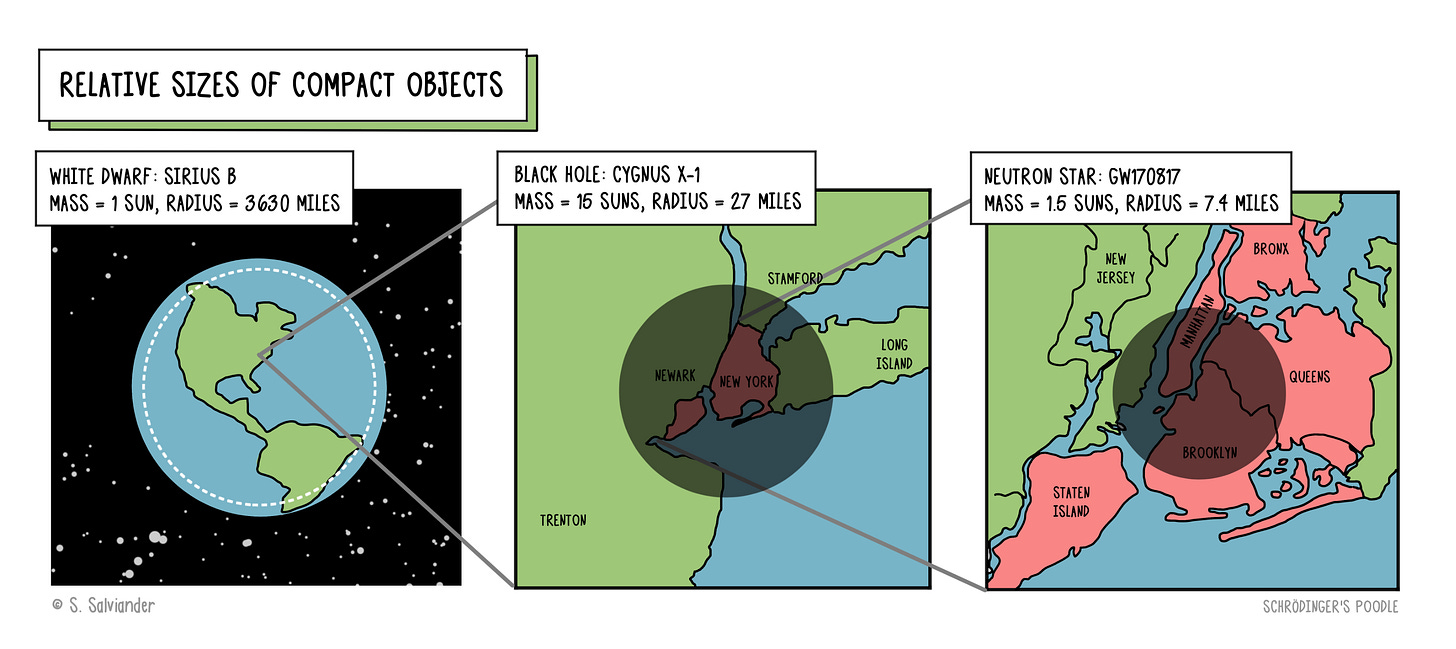Compact objects
How objects in the stellar graveyard compare with Earth and New York City
When anyone teaches astronomy at the university level, there’s always a section on “the stellar graveyard.” This refers to the objects left over after stars effectively die. It has a nice rhetorical sound to it. When astrophysicists talk to each other about objects in the stellar graveyard, we refer to them by the much more dry-sounding term, “compact objects.” Because, as you’ll see, they’re really, really compact compared with what else is out there in the universe.
So, how does a star die, you might be wondering? Is a star even alive so that it can die? Sort of, yes.
A star dies when it stops doing star-things. Mainly, that means when it stops fusing lighter elements into heavier elements, something it does to generate energy. This is how a star shines, and thank goodness for that, because sunshine keeps us alive on Earth. But this energy also keeps the star alive by allowing it to push back against the relentless crush of gravity.
That might sound kind of odd, because gravity doesn’t feel very crushy to us on Earth. That’s because gravity is actually a pretty weak force. As I explain to my students, you can overcome the gravity of the entire planet with just a small refrigerator magnet. (Dazzle your kids with this fact by using a fridge magnet to pick up a paperclip. Voila, Earth’s gravity defeated.) The other three fundamental forces, including the electromagnetic force, are orders of magnitude stronger than gravity.
But once you get to the scale of a star, gravity becomes a big player. And it really wants to crush a star. Stars have ways of resisting that, beginning with the outward pressure generated by fusion energy.
When a star runs out of nuclear fuel and stops doing that, gravity gets the upper hand until it runs into another kind of pressure, called degeneracy pressure.1 This is a quantum mechanical effect, and it just means that certain types of particles, like electrons and neutrons, don’t want to be too close to each other.
The first stop after a star is no longer generating energy from nuclear fusion is an object called a white dwarf, the name astrophysicists came up with for the burned out core of a former star. A white dwarf is held together against the crush of gravity by electron degeneracy pressure, the resistance of electrons against being smushed too close together. The white dwarf starts off hot and glowing, but eventually radiates all of its leftover star energy into space and become a cold, dense hunk of inert matter. This will be the fate of our Sun when it dies.
The next stop, if the former star was massive enough, is a neutron star. In this case, gravity overcomes the electron degeneracy pressure and the former star is crushed down to the point that protons and electrons are squished together, and all you’re left with a big sphere of mostly neutrons.
If the star was really massive, then gravity can even overcome the neutron degeneracy pressure. When that happens, there’s nothing left to stop gravity. It crushes that former star so utterly and completely that it produces a literal hole in space—what we call a black hole. That’s the final stop for a really massive star.
To give you a sense of how big these objects are, I compare them with the sizes of more familiar things—the Earth and New York City. [Click to enlarge the cartoon.] This is how big a white dwarf, a neutron star, and a black hole are, respectively. Keep in mind that the masses of these objects are approximately one to many times the mass of the Sun. That means they’re ridiculously dense.
If you’re as fascinated by these objects as I am, I have two books to recommend to you. The first is Black Holes and Time Warps: Einstein’s Outrageous Legacy by Kip Thorne. It’s equal parts history, biography, and science, and it’s hands-down one of my favorite popular science books of all time. The other is The Story of the Cosmos, specifically the chapter I wrote about the history of the discovery of black holes and how it relates to God’s hiddenness. (I don’t get anything if you buy these books, I just think you should check ‘em out.)
When physicists talk about degeneracy in this context, they don’t mean a low moral state, but rather a state in which the Pauli exclusion principle applies. No two fermions (electrons and neutrons in this case) can occupy the same quantum energy level, and when matter made out of these particles becomes very dense, this quantum mechanical effect generates pressure as the particles resist being squeezed too close together.




I love this! I've read The Story of the Cosmos, and you really did your best to put the cookies on the bottom shelf, but still above my pay grade lol. Highly recommend the book. I can't wrap my brain around an exploding star leaving a gravitational hole. This article helps me visualize it even better. It's just incredible. Do we know where the gravity comes from? (Maybe everyone does and I haven't been paying attention.)
Ha, no, I didn't think it was commentary. You're too smart for that. I'm not.